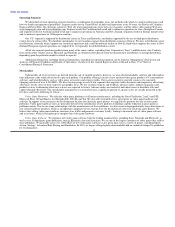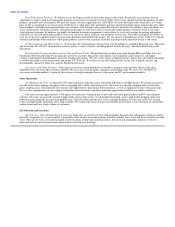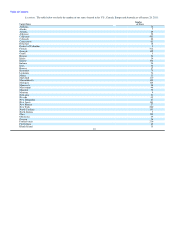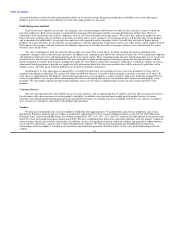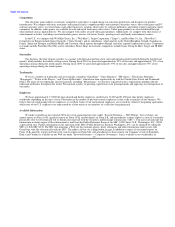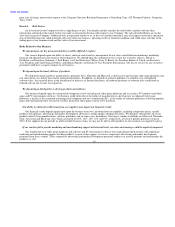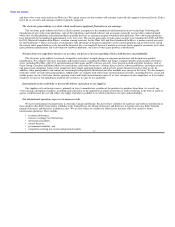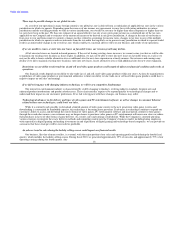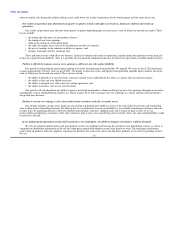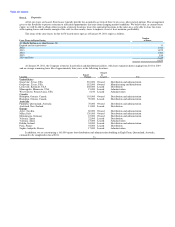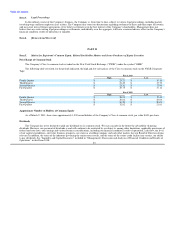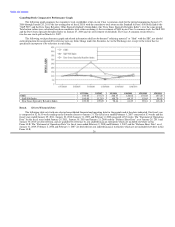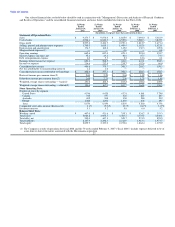GameStop 2010 Annual Report Download - page 33
Download and view the complete annual report
Please find page 33 of the 2010 GameStop annual report below. You can navigate through the pages in the report by either clicking on the pages listed below, or by using the keyword search tool below to find specific information within the annual report.
Table of Contents
and drive sales at our stores and on our Web sites. We cannot assure you that vendors will continue to provide this support at historical levels. If they
fail to do so, our sales and earnings could be negatively impacted.
The electronic game industry is cyclical, which could cause significant fluctuation in our earnings.
The electronic game industry has been cyclical in nature in response to the introduction and maturation of new technology. Following the
introduction of new video game platforms, sales of these platforms and related software and accessories generally increase due to initial demand,
while sales of older platforms and related products generally decrease as customers migrate toward the new platforms. New video game platforms
have historically been introduced approximately every five years. The current generation of video game consoles were introduced in 2005 and 2006.
In 2010, Microsoft introduced the Kinect, a motion sensing accessory for the Xbox 360, and Sony introduced the Move, a motion control accessory
for the PlayStation 3. These accessories are designed to take advantage of the processing power in the current platforms and are believed to extend
the current video game hardware cycle beyond the historical five-year length. If these new motion accessories fail to appeal to consumers or if video
game platform manufacturers fail to develop new hardware platforms, our sales of video game products could decline.
Pressure from our competitors may force us to reduce our prices or increase spending, which could decrease our profitability.
The electronic game industry is intensely competitive and subject to rapid changes in consumer preferences and frequent new product
introductions. We compete with mass merchants and regional chains, including Wal-Mart and Target; computer product and consumer electronics
stores, including Best Buy; other U.S. and international video game and PC software specialty stores located in malls and other locations, such as
Game Group, Carrefour and Media Markt; toy retail chains; mail-order businesses; catalogs; direct sales by software publishers; and online retailers
and game rental companies. Some of our competitors have longer operating histories and may have greater financial resources than we do. In
addition, video game products and content are increasingly being digitally distributed and other methods may emerge in the future. We also compete
with other sellers of used video game products. Additionally, we compete with other forms of entertainment activities, including browser, social and
mobile games, movies, television, theater, sporting events and family entertainment centers. If we lose customers to our competitors, or if we reduce
our prices or increase our spending to maintain our customers, we may be less profitable.
International events could delay or prevent the delivery of products to our suppliers.
Our suppliers rely on foreign sources, primarily in Asia, to manufacture a portion of the products we purchase from them. As a result, any
event causing a disruption of imports, including natural disasters or the imposition of import restrictions or trade restrictions in the form of tariffs or
quotas, could increase the cost and reduce the supply of products available to us, which could lower our sales and profitability.
Our international operations expose us to numerous risks.
We have international retail operations in Australia, Canada and Europe. Because release schedules for hardware and software introduction in
these markets often differ from release schedules in the United States, the timing of increases and decreases in foreign sales may differ from the
timing of increases and decreases in domestic sales. We are also subject to a number of other factors that may affect our current or future
international operations. These include:
• economic downturns;
• currency exchange rate fluctuations;
• international incidents;
• natural disasters;
• government instability; and
• competitors entering our current and potential markets. 17



